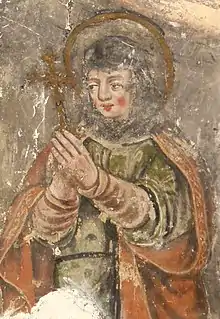Saint Aurea of Paris
Aurea of Paris; (died 666; French: Sainte Aure), venerated as Saint Aurea of Paris, was an abbess of Saint Martial in Paris in the seventh century.[1][2] Dagoburt I and Clovis II ruled at the time.[3] Her feast day was originally the 4th October, however, this was transferred to the 5th October following the veneration of St Francis of Assisi.[3]

She appears in works by two writers, St Ouen and Jonas of Bobbio, in their hagiography (saint's life stories) of St Eligius and St Eustace.[1] Both writers state that she was an immigrant to Paris from Syria. She died "with one hundred and sixty of her sisters" of the plague in 666.[3]
Aurea's relics are held at the church of St Eloi in Paris.[1] In the same church, there is also a mural of her receiving the veil from St Eloi.[4]
Miracles
Aurea was believed to have brought a woman back to life, so that she could release a key from her dead hands; to have swept red-hot ashes out of an empty oven, seemingly causing well-baked loaves to appear; and, long after death, to have cured a blind woman with the touch of her cut-off (and freshly bleeding) arm.[1]
References
- Baring-Gould, Sabine (1877). The Lives of the Saints. J. Hodges. pp. 66–68.
- Bunson, Matthew; Aumann, Jordan; Bunson, Margaret; Bunson, Stephen (1998). Our Sunday Visitor's Encyclopedia of Saints. Our Sunday Visitor. p. 108. ISBN 978-0-87973-588-3.
- McClintock, John (1885). Cyclopedia of Biblical, Theological, and Ecclesiastical Literature: Supplement. Harper. p. 266.
- Galignani, A.; Galignani, W. (1868). New Paris Guide: For 1868. p. 279.